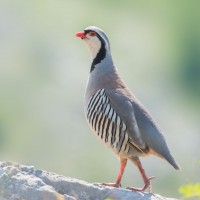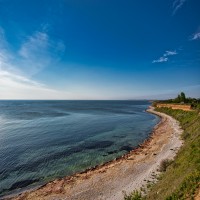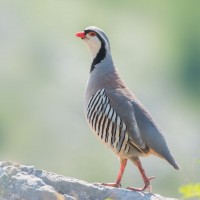- Overview
- Full Itinerary
- Photo Gallery
- Costing
- Travel Details
- Trip Reports
- Guide
- Map
- Know Before You Go
- Other Trips You May Like
Special Offer: Book along with our Fall Spain tour and receive a complimentary night in Bucharest on Sept. 19 + $200 discount per person.
Join us on this Naturalist Journeys tour, following the coastal regions of Romania and Bulgaria along the Black Sea. Our visit is timed perfectly during the peak of fall migration on one of Europe’s biggest bird migration routes, nicknamed the ‘Via Pontica’ after the ancient Roman road that traversed this same region.
We spend the first half of the tour in the ancient Dobrudja region shared with both Bulgaria and Romania. Here, we explore shallow brackish lagoons, sandy beaches, freshwater marshes and reedbeds that host many passage migrants from raptors to waterfowl to shorebirds heading south from Russia towards the Middle East and Africa. Species we should see include Dalmatian and Great White Pelicans, Pygmy Cormorant, Red-footed Falcon, and Whiskered and White-winged Terns. Inland areas of this region also feature the flat steppes, the only example of this vast biome in the European Union and home to a rich variety of nesting grassland birds such as Pied and Black-eared Wheatears, Calandra and Greater Short-toed Larks, and Long-legged Buzzard.
We finish our journey on the southern coast of Bulgaria, visiting the wetlands around Bourgas and the broad-leaved forests of the Strandzha Hills, providing us with an entirely new habitat rich in woodpeckers such as Syrian, White-backed, Lesser Spotted, and Black.
We will also not neglect other wildlife and visit some Thracian and Roman historical and cultural sites as we travel through this fascinating part of Europe, some of the oldest inhabited areas on the continent. So, come join us and feel the excitement of seeing large numbers of birds on the move in the culturally and historically rich countries of Romania and Bulgaria!




- “A slow paced, small group tour of the Romanian section of the beautiful Danube Delta and Bulgarian Black Sea Coast natural reserves. We visited a number of ancient historic sites and enjoyed local foods and wines. Top highlights: 1. Spending time in uncrowded, quiet natural reserves with excellently trained group leaders who shared their extensive knowledge with us. I learned so much. 2. Collecting over 150 lifer birds. Especially the White Backed Woodpecker.” — Kathleen Costello Bar Tur, 2023 Traveler
- “Beyond expectations. Numerous new species for me.” — Colette Dubuisson, 2023 Traveler
Tour Highlights
- Experience the thrill of fall bird migration on Europe’s second-largest migratory pathway, nicknamed the ‘Via Pontica’ after an ancient Roman road
- Observe a wide variety of European waterbirds, from the diminutive Pygmy Cormorant to the colossal Dalmatian Pelican
- Stay at quaint, picturesque towns on your birding travels rich in history and steeped in folkloric customs
- Visit grasslands and stony steppe, a semi-arid grassland, to see Eurasian Thick-knee, European Bee-eater, European Roller, and Pied Wheatear
- Spend time with one of the most experienced European guides, Gerard Gorman
- Marvel at raptor migration as they pass overhead at key bottleneck points such as Cape Kaliakra




Trip Itinerary
Itineraries are guidelines; variations in itinerary may occur to account for weather, road conditions, closures, etc. and to maximize your experience.
Fri., Sept. 20 : Arrivals in Romania | Sinoe
Welcome to Romania! Arrive at Bucharest Henri Coanda International Airport (OTP), where our guide, Gerard Gorman, welcomes the group. Then, we take a 3 hour drive eastward to the Dobrudja region along Romania’s Black Sea coast. We spend our first three nights in a small hotel in the village of Sinoe.
Accommodations in the town of Sinoe (D)
Sat., Sept. 21 & Sun., Sept. 22 : Black Sea Coast Birding | Dobrudja
We spend two days on Romania’s Black Sea coast, in the northern part of the historical Dobrudja region shared with Bulgaria. There will be optional pre-breakfast birding excursions on both days, perhaps to some nearby pools and wetlands nearby to see a variety of shorebirds such as Spotted Redshank and Curlew Sandpiper.
After breakfast, we have a full day to explore the natural history and birdlife of this beautiful region. Brackish and freshwater wetlands around the Danube River delta, the most extensive wetland ecosystem in Europe, are home to Common and Ruddy Shelduck, Little and Great Crested Grebe, Little and Mediterranean Gull, Pygmy and Great Cormorant. A long list of European shorebirds also migrates through the area in the fall, including Marsh and Wood Sandpiper, Spotted and Common Redshank, Little and Temminck’s Stint, and Little Ringed and Kentish Plover.
The Dobrudja region also features dry steppe habitats with many species that are hard to find elsewhere in Europe. The mosaic of dry grasslands, farmland, and woodland harbors European Bee-eater, European Roller, Long-legged Buzzard, Red-footed Falcon, Crested Lark, Eurasian Golden-Oriole, and many others.
Migrating Red-breasted Flycatchers and other songbirds are often in bushes this time of year. We will also probably see our first flocks of passage storks, pelicans and raptors moving southwards. A real highlight is being able to see both Great White and Dalmatian Pelican loafing in the wetlands or flying overhead. Dalmatian Pelican is an impressive species, the most massive member of the pelican family and perhaps the world’s largest water bird.
Accommodations in the town of Sinoe (B,L,D)
Mon., Sept. 23 : Birding all the way to Bulgaria!
After breakfast, we head south by road to Bulgaria, often hugging the coast and birding along the way. We make numerous stops and check the roadside wires and trees. Common Swift, Alpine Swift, Common House-Martin, and Red-rumped Swallow are often flying over the fields and towns, while we keep an eye open for Little Owl perching stoically on village rooftops. Finally, we arrive in the small seaside settlement of Krapets in northern Bulgaria, the southern portion of the Dobrudja region. Krapets is a sleepy town surrounded by vast wheat and sunflower fields, known for its dunes and rich birdlife.
Accommodations in the town of Krapets (B,L,D)
Tues., Sept. 24 & Wed., Sept. 25 : Lakes of Northern Bulgaria | Krapets
We have two full days to explore various sites on the northern coast of Bulgaria. Lake Shabla is a semi-saline lagoon, separated from the sea by high sand dunes. The edges of the lagoon feature huge reedbeds, while large areas of open, shallow water rich with food attract large numbers of migrating birds in the early fall. Here, we may see Whiskered and White-winged Tern, Slender-billed Gull, Pied Avocet, Black-tailed Godwit, Broad-billed Sandpiper, Pied Avocet, Ferruginous Duck, and Garganey.
Lake Durankulak is another coastal wetland to the north of Lake Shabla, also separated from the sea by high sand dunes. The mix here is slightly different from that of Lake Shabla, and here we may see Eared Grebe, Purple Heron, Common Kingfisher, Syrian Woodpecker, Bearded Reedling, and Eurasian Penduline-Tit.
Cape Kaliakra, a highlight of our time here on the Bulgarian coast, is a narrow headland that juts out into the sea with sweeping views. The remnants of a medieval fortress and its fortified walls feature prominently on the headland, the remains of the Principality of Karvuna’s medieval capital. The ruins and nearby stony steppe host Pied Wheatear, Red-backed Shrike, Crested Lark, Spotted Flycatcher, Common Redstart, and Eurasian Thick-knee. Kaliakra’s steep cliffs host gulls and the Black Sea race of European Shag, a marine cormorant. We might also see Yelkouan Shearwaters skimming the surface of the sea from land here, as well. If weather conditions are in our favor, the cape is a migratory bottleneck with migrating raptors moving overhead in large numbers. Short-toed, Lesser Spotted and Booted Eagles, Levant and Eurasian Sparrowhawks, European Honey-Buzzard, Western Marsh- and Montagu’s Harriers, Eurasian Hobby and Red-footed Falcon all travel down the western Black Sea in fall migration. We will check for a roosting Eurasian Eagle-Owl, too.
Accommodations in the town of Krapets (B,L,D)
Thurs., Sept. 26 : Balkan Mountains | Sozopol
We continue our journey today southward, stopping on the eastern edge of the Balkan Mountains and at coastal riverine forests. Depending on the latest bird migration news, we may visit raptor watchpoints to watch raptors such as European Honey-Buzzard, Levant Sparrowhawk, and Red-footed Falcon move overhead. We may also stop by a banding station, where a range of Old World warblers, Bluethroat, Eurasian Wryneck, and other European bird species can be observed in the hand at very close range—not only observing details that are hard to notice in the field but also learning about their migratory journey through Eastern Europe and beyond.
Finally, we arrive in the delightful town of Sozopol—our home for three nights. Founded in the 7th century by Greek merchants, it is one of the oldest port cities in Bulgaria. This historical town is an excellent base from which to explore the birding sites of southern Bulgaria’s Black Sea coast.
Accommodations in the town of Sozopol (B,L,D)
Fri., Sept. 27 : Saline Lagoons & Freshwater Lakes in Bourgas
Today, we bird several wetlands on the coast of southern Bulgaria, including deep freshwater lakes and shallow saline lagoons around Bourgas. The saltpans at Pomorie are often a great place for shorebirds, egrets and herons. Lakes Bourgas, Mandra, and Atanasovsko are often very busy with birds in fall, with both resident species and migratory species using the lagoon as a refueling station before continuing their journey to the Middle East and Africa. Great White and Dalmatian Pelicans, White and Black Storks, European Honey-Buzzard, Booted, Short-toed and Lesser Spotted Eagles, Black Kite, and Levant Sparrowhawk are all species we may observe. Other likely birds include Purple Heron, Squacco Heron, Black-winged Stilt, Temminck’s Stint, Red-necked Phalarope, Slender-billed Gull, Little Gull, Gull-billed Tern, and White-winged Tern. Rarities like Terek Sandpiper and Broad-billed Sandpiper are also possible.
Accommodations in the town of Sozopol (B,L,D)
Sat., Sept. 28 : Woodpeckers Galore in the Forests of Strandzha Hills
On our final full day of the tour, we head inland to the broad-leaved forests of the Strandzha Hills. This is an excellent area for woodpeckers, and we may see Syrian, White-backed, Middle Spotted, Lesser Spotted, Great Spotted, and Eurasian Green Woodpecker here. We should also see Black Woodpecker. Slightly larger than North America’s Pileated Woodpecker, Black Woodpecker is the largest species of its family in Europe. Other targets include Hawfinch, Cirl Bunting, Short-toed Treecreeper, Eurasian Nuthatch, Firecrest, Goldcrest, Sombre Tit, and Long-tailed Tit. We also visit the Ropotamo wetland and coastal sand dunes. As usual, we will keep scanning the skies for migrating bird flocks, too!
Accommodations in the town of Sozopol (B,L,D)
Sun., Sept. 29 : Departures from Bulgaria
After breakfast we head inland to Sofia, the capital of Bulgaria, where the tour ends. Please schedule departures for the afternoon or stay on in the city. (B)
Cost of the Journey
Cost of the Journey is per person, based on occupancy: $4,290 DBL / $4,790 SGL.
The tour cost includes airport transfers, 9 nights’ accommodations, all meals from dinner on the first day through breakfast Day 10, professional guide services, park and preserve entrance fees, and miscellaneous program expenses.
The tour cost does not include airfare from your home to Bucharest, Romania or items of a personal nature, such as drinks from the bar, telephone, and local guide gratuities (at your discretion, we will give some guidelines).
Travel Details
Please plan to make air travel plans only after the minimum group size has been met. We will send you a confirmation email as soon as the trip has been confirmed.
Arrival: Plan to arrive in the morning on Friday, September 20, 2024, no later than noon. Your guide will pick up at the airport and the nearby Hilton Garden Inn Bucharest Airport at 1PM for a 3.5-hour drive to your first night stay.
Arrival Airport: Bucharest Henri Coanda International (OTP), Bucharest, Romania
Departure: September 29, 2024 in the late-afternoon or evening. You have a four hour drive back from the last hotel of the journey, and you need to be at the airport three hours ahead of your flight.
Departure Airport: Sofia International Airport (SOF), Sofia, Bulgaria
Travel Tips and Extra Services: As our birding and nature tour hotels are all out of the cities, please book your hotel directly for early arrival or extra time. If you want just a place to rest up, the Hilton Garden Inn Bucharest Airport is easy to book online and convenient for the arrival. There is another Hilton Garden Old Town in the city, and any number of boutique or historic hotels. You can also work with our travel agent for ideas for this city time. We are experts in the birding and nature aspects; we do not have city tours or other services, but there are loads of great suggestions online. Here are a couple of helpful sites that might be helpful in addition to Frommers, Fodors, etc.
- https://travelnotesandbeyond.com/things-to-do-in-bucharest-romania/ https://teaspoonofnose.com/sofia-bulgaria/
- https://teaspoonofnose.com/sofia-bulgaria/
Entry Requirements: See "Essential Information" section under the "Know Before You Go” tab.
Browse below for trip reports and species lists from past versions of this and other tours from this destination.
Romania & Bulgaria
- September 2023
- September 2024
-
Gerard Gorman

Gerard Gorman is a deeply experienced birding and wildlife guide, particularly in Central and Eastern Europe where his knowledge of the wildlife sites of the region is second to none, having visited every country from the Baltic to the Black Sea. In recent years he has led several Naturalist Journeys groups across Europe and Africa. Gerard is also an author, and his books include Central and Eastern European Wildlife (Bradt, 2008) and Birding in Eastern Europe (WildSounds, 2006). His main ornithological interest focuses on woodpeckers, and he is regarded as an authority, authoring an unprecedented seven books on the family, including the acclaimed Woodpeckers of the World (Bloomsbury, 2014) and Woodpecker (Reaktion, 2017). His latest works include, The Wryneck (Pelagic Publishing, 2022), the definitive monograph on this fascinating species, and The Green Woodpecker (Pelagic Publishing, 2023). Gerard is also interested in wildlife tracking, and his Pocket Guide to Tracks and Signs of European Wildlife (Bloomsbury) was published in 2014.
Photo credit: probirder.com
Other trips with Gerard Gorman
-
 Captivating Croatia: Birding the Adriatic Coast FULL - Check out Romania & Bulgaria: Black Sea Coast Migration!April 8 - 20, 2025
Captivating Croatia: Birding the Adriatic Coast FULL - Check out Romania & Bulgaria: Black Sea Coast Migration!April 8 - 20, 2025 -
 Finland & Norway: Birding & Nature CLOSED - See our 2026 departure!June 4 - 16, 2025
Finland & Norway: Birding & Nature CLOSED - See our 2026 departure!June 4 - 16, 2025 -
 Romania & Bulgaria: Black Sea Coast MigrationSeptember 20 - 29, 2025
Romania & Bulgaria: Black Sea Coast MigrationSeptember 20 - 29, 2025 -
 Captivating Croatia: Birding the Adriatic CoastApril 11 - 23, 2026
Captivating Croatia: Birding the Adriatic CoastApril 11 - 23, 2026 -
 Finland & Norway: Birding & NatureJune 4 - 16, 2026
Finland & Norway: Birding & NatureJune 4 - 16, 2026
-
Essential Information +
Pace & Protocols +
Packing List +
Suggested Reading List +
Useful Links +
Photo credits: Banners: Sozopol (NJ Stock), Great White Pelicans (Dimiter Georgiev), Pied Wheatear (NJ Stock), European Bee-eater (NJ Stock), Thumbnails: Syrian Woodpecker (NJ Stock), Eurasian Thick-knee (NJ Stock), European Bee-eater (NJ Stock), Red-footed Falcon (NJ Stock), Eurasian Roller (NJ Stock), Pygmy Cormorant (NJ Stock), Black Woodpecker 9NJ Stock), Pied Wheatear (NJ Stock)





















